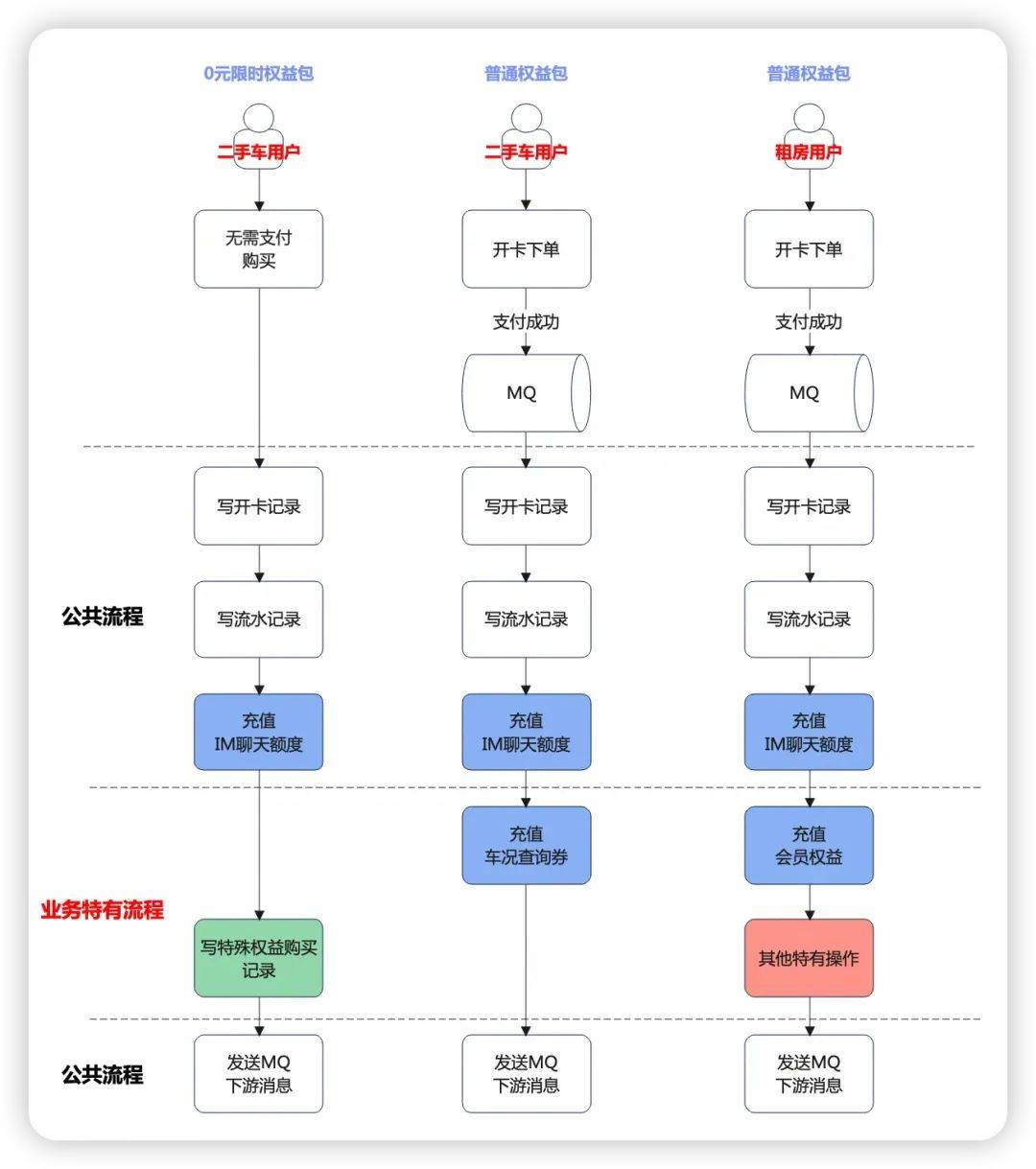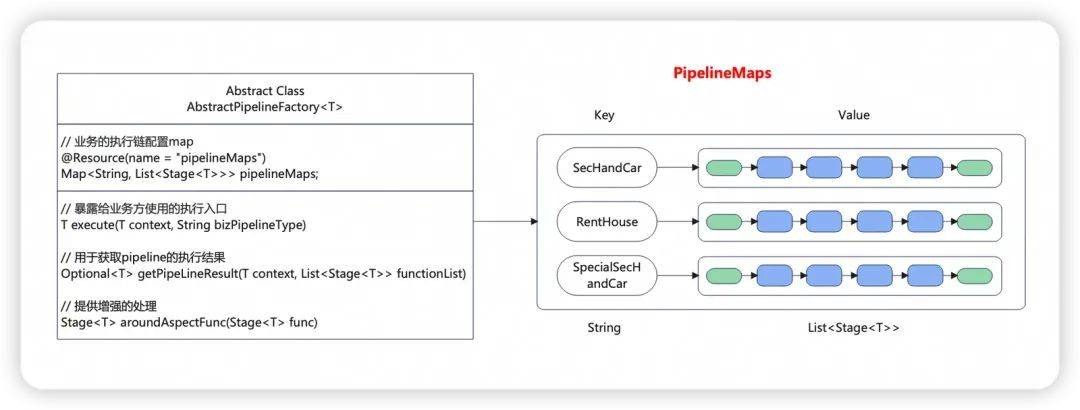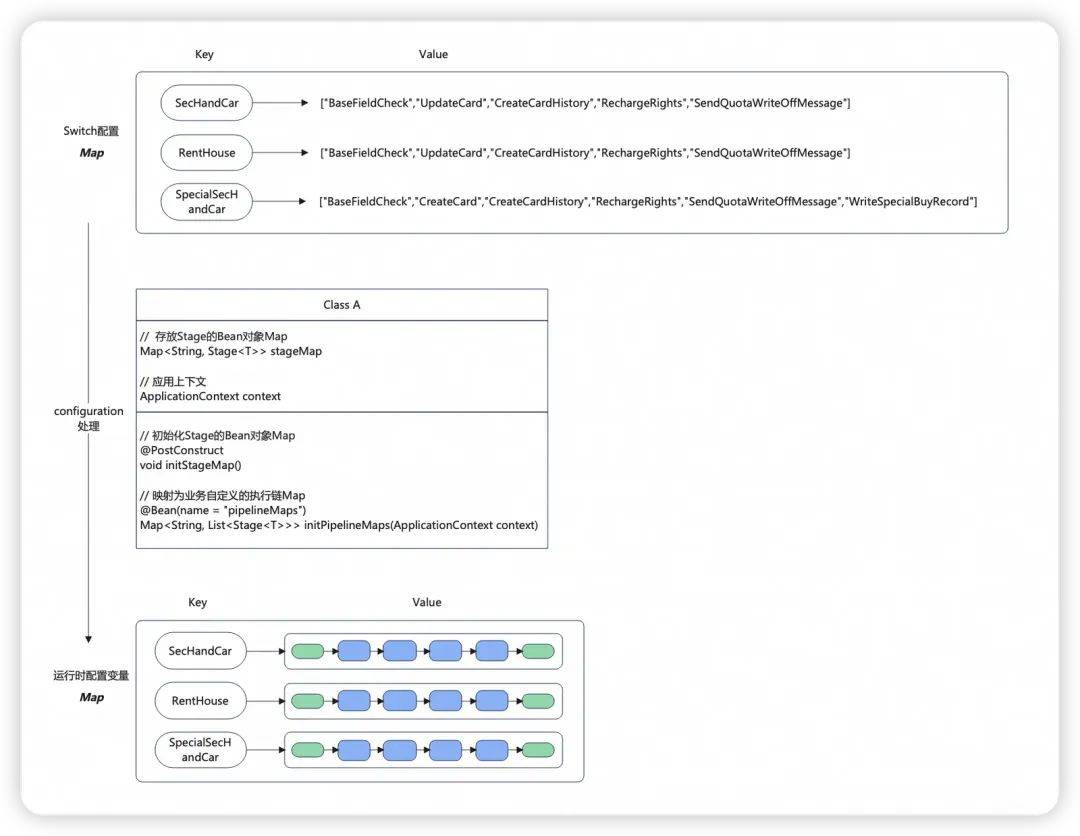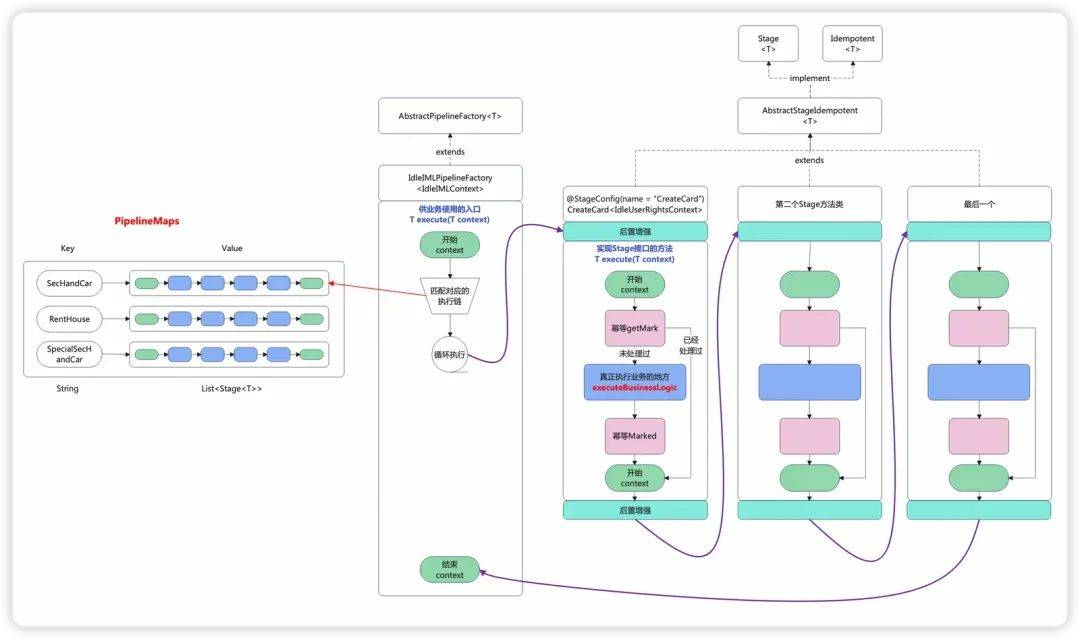包阅导读总结
1. 关键词:Pipeline 设计、幂等重试、闲鱼同城、通用框架、商业化需求
2. 总结:本文讲述闲鱼同城模块中针对二手车和租房等业务的商业化需求,设计基于 Pipeline 模式和幂等性控制的通用框架,介绍了相关类和接口定义及业务的 Stage 方法类实现。
3. 主要内容:
– 闲鱼同城业务背景
– 二手车和租房等业务有商业化需求,功能有重合部分。
– 原方案及问题
– 用模版方法设计模式抽象流程,固定且不易变动扩展,部分方法执行失败无法幂等。
– 新的通用框架
– 采用责任链模式变体 Pipeline 设计,定义基本类和接口,包括上下文、Stage 接口、幂等接口等。
– 定义抽象幂等模版类和业务自己的上下文类等。
– 定义抽象 Pipeline 执行工厂。
– 实现业务自己的 Stage 方法类,用自定义注解标记。
思维导图:
文章地址:https://mp.weixin.qq.com/s/bBZFDx6WwRfTnfQS08Mesg
文章来源:mp.weixin.qq.com
作者:绿健
发布时间:2024/8/5 10:22
语言:中文
总字数:5810字
预计阅读时间:24分钟
评分:89分
标签:通用框架,Pipeline设计,幂等性控制,闲鱼同城,阿里云开发者
以下为原文内容
本内容来源于用户推荐转载,旨在分享知识与观点,如有侵权请联系删除 联系邮箱 media@ilingban.com

闲鱼同城模块中有很多不同的业务,例如二手车、租房、本地租等等。
最近我和师兄在完成闲鱼同城的二手车商业化需求,发现租房的商业化需求也同步进行着,在对齐双方的功能时,发现有很多重合部分。
这里简单说明下我们的商业化方案(二手车、租房基本一致),下图为部分视觉稿。

这里给出简单的流程,对于二手车和租房,两侧有一些共有的业务流程、也有业务侧特有的流程,如下图。

二手车这边除了普通权益包购买流程之外,额外有一个0元限时权益包的购买流程,即是无需用户支付付款的流程,而租房那边暂时没有这个流程。在上图蓝色块中,是双方充值权益的流程,有共有的【IM聊天额度】,也有特有的【会员权益】、【车况查询券】。
通过前面的业务背景介绍,很容易想到用模版方法的设计模式来抽象上述流程,给出一个抽象的模版类,拆分上面的执行流程,提供一个工厂类来组合这些方法供业务类去调用。
不同业务在实现时,只需要继承这个抽象类,重写里面的方法即可。
package com.alibaba.idle.service;import com.alibaba.idle.local.service.IdleUserRightsService;import lombok.RequiredArgsConstructor;@RequiredArgsConstructorpublic abstract class AbstractUserRightsTemplate {private final IdleUserRightsService userRightsService;public abstract void beforeProcedure();public void commonProcedure() {userRightsService.writeRightsCard();userRightsService.writeRightsHistory();userRightsService.rechargeIMRights();}public abstract void specialProcedure();public void afterProcedure() {userRightsService.sendMetaQMessage();}}
模版方法里面的流程固定死了,不易变动和扩展。如果有一个新的业务方来了,不需要充值IM权益时,上述模版就不适用了,且如果其中部分方法执行失败时,无法做到幂等。因此我们需要一个可通用扩展的代码框架,并且保障局部失败重试时的幂等控制。
如果改用责任链模式的变体Pipeline来设计,将其中每一个方法视作Pipeline中的一个阶段(Stage),每个Stage都可以选择性的进行幂等控制,那么这样就实现了我们的框架需求。
如下图所示,Pipeline是一个执行链,其中的操作节点可以定义为Stage,还需要额外定一个context用于上下文传递使用。

那么,如果有不同的业务时,就可以定义不同的Pipeline执行流程,对于其中共性的Stage方法,可以进行复用,也可以进行业务方特有的扩展。
如下图所示,A、B、C业务都有一个共性的Stage A需要执行,A和C有一个Stage B需要执行,依次类推。这样就可以实现灵活复用的一个框架。

3.2.1 基本类、接口定义
1.定义上下文BasePipelineContext用于Pipeline中传递参数;
BasePipelineContext
@Datapublic class BasePipelineContext implements Serializable {private Map<String, String> extInfo;private StageProcessedResultEnum result;}
2.定义Pipeline中的基本方法类为Stage接口,其中泛型T继承自BasePipelineContext类;
Stage
public interface Stage<T extends BasePipelineContext> {T execute(T context);}
3.定义Idempotent接口用于实现幂等操作;
Idempotent
public interface Idempotent<T extends BasePipelineContext> {String getIdempotentKey(T context);}
4.定义一个抽象的幂等模版类AbstractStageIdempotent,实现Stage、Idempotent接口,用于在Stage方法执行的前后加上幂等的校验,其中幂等的实现依赖于TairStringInterface接口;
AbstractStageIdempotent
@Slf4jpublic abstract class AbstractStageIdempotent<T extends BasePipelineContext> implements Stage<T>, Idempotent<T> {public static final String APP_NAME = "***";@Autowiredprivate TairStringInterface tairStringInterface;protected abstract T executeBusinessLogic(T context);@Overridepublic T execute(T context){String simpleName = this.getClass().getSimpleName();String idempotentKey = getIdempotentKey(context);String key = TairKeysConstantsTools.generateKey(CommonCharEnum.MINUS.getValue(), APP_NAME, simpleName, idempotentKey);try {if (idempotentKey != null && getMark(key, context)) {log.info(simpleName + " is already processed, the idempotent key:{}", key);return context;}context = executeBusinessLogic(context);if (idempotentKey != null && context.getResult() != null && context.getResult().isSuccess()) {if(!marked(key, context)) {log.error(simpleName + " marked error, the idempotent key:{}", key);context.setResult(StageProcessedResultEnum.IDEMPOTENT_FAIL);}log.info(simpleName + " execute success, marked idempotent key:{}", key);}} catch (Exception e) {log.error(simpleName + " execute error, the idempotent key:{}, context:{}", key, e, context);context.setResult(StageProcessedResultEnum.IDEMPOTENT_FAIL);}return context;}private boolean getMark(String key, T context) {ExgetResult<String> result = tairStringInterface.exget(key);if (result != null && StringUtil.isNotEmpty(result.getValue())) {return "1".equals(result);}return false;}private boolean marked(String key, T context) {ExsetParams params = new ExsetParams().nx().ex(SwitchConfigBiz.pipeLineIdempotentExpireTime);String reply = tairStringInterface.exset(key, "1", params);return "OK".equals(reply);}}
5.定义业务自己的上下文类Context,业务的Stage方法类只需要继承自AbstractStageIdempotent,泛型参数T继承自BasePipelineContext的任何类即可,这里以我们自定义的一个IdleUserRightsContext(继承自BasePipelineContext)为例;
IdleUserRightsContext
@Datapublic class IdleUserRightsContext extends BasePipelineContext {private IdleUserRightsCardDTO card;public IdleUserRightsContext ofResult(StageProcessedResultEnum result) {super.setResult(result);return this;}}
6.定义一个抽象的Pipeline执行工厂,用于暴露给业务方使用,工厂中完成pipeline的执行、前后的日志打印等操作;
AbstractPipelineFactory
@Slf4jpublic abstract class AbstractPipelineFactory<T extends BasePipelineContext> {@Resource(name = "pipelineMaps")private Map<String, List<Stage<T>>> pipelineMaps;public T execute(T context, String bizPipelineType) {List<Stage<T>> executeChains = pipelineMaps.get(bizPipelineType);if(CollectionUtils.isEmpty(executeChains)) {log.error("PipelineFactory execute error executeChains is null, bizPipelineType:{}", bizPipelineType);return null;}log.info("PipelineFactory execute, bizPipelineType:{}, executeChains:{}", bizPipelineType, executeChains);List<Stage<T>> enhancedFunctionList = executeChains.stream().map(this::aroundAspectFunc).collect(Collectors.toList());return getPipeLineResult(context, enhancedFunctionList).orElse(context);}private Optional<T> getPipeLineResult(T context, List<Stage<T>> functionList) {if (CollectionUtils.isEmpty(functionList)) {return Optional.empty();}for (Stage<T> f : functionList) {if(Objects.isNull(context)) {return Optional.empty();}if(context.getResult() != null && context.getResult().equals(StageProcessedResultEnum.SKIP_ALL)) {break;}context = f.execute(context);}return Optional.ofNullable(context);}private Stage<T> aroundAspectFunc(Stage<T> func) {return req -> {StageConfig annotation = func.getClass().getAnnotation(StageConfig.class);String methodName = annotation.name();if(!preContextCheck(methodName, req)) {return null;}T result = func.execute(req);afterResult(methodName, result);return result;};}protected boolean preContextCheck(String methodName, T context) {if(context == null) {log.error("PipelineFactory.execute [{}] error, context is null", methodName);return false;}if(context.getResult() != null && !context.getResult().isSuccess()) {log.error("UserRightsPipelineFactory.execute [{}] error, pre method is failed with resultEnum:{}", methodName, context.getResult());return false;}log.info("PipelineFactory.execute [{}] start, context:{}", methodName, context);return true;}protected void afterResult(String methodName,T context) {log.info("PipelineFactory.execute [{}] end, context:{}", methodName, context);}}
7.最后实现业务自己的Stage方法类。
CreateCard
@Slf4j@StageConfig(name = "CreateCard")@RequiredArgsConstructorpublic class CreateCard extends AbstractStageIdempotent<IdleUserRightsContext> {private final IdleUserRightsService userRightsService;@Overrideprotected IdleUserRightsContext executeBusinessLogic(IdleUserRightsContext context) {IdleUserRightsCardDTO cardDTO = context.getCard();Long cardId = userRightsService.createCard(cardDTO);cardDTO.setId(cardId);return context.ofResult(cardId == null ? StageProcessedResultEnum.WRITE_USER_RIGHTS_RECORD_DB_FAIL : StageProcessedResultEnum.SUCCESS);}@Overridepublic String getIdempotentKey(IdleUserRightsContext context) {IdleUserRightsCardDTO card = context.getCard();return card.getIdempotentKey() != null ? card.getIdempotentKey() : TairKeysConstantsTools.generateKey(CommonCharEnum.MINUS.getValue(), String.valueOf(card.getUserId()), card.getBizCode(), card.getTemplateCode());}}
CreateCardHistory
@Slf4j@StageConfig(name = "CreateCardHistory")@RequiredArgsConstructorpublic class CreateCardHistory extends AbstractStageIdempotent<IdleUserRightsContext> {private final IdleUserRightsService userRightsService;private final IdleIMLimitQuotaDataService quotaDataService;@Overrideprotected IdleUserRightsContext executeBusinessLogic(IdleUserRightsContext context) {IdleUserRightsCardDTO card = context.getCard();IdleUserRightsCardHistoryDTO historyDTO = userRightsService.buildHistory(card);historyDTO.setPaidCntLeft(paidCntLeft + historyDTO.getCount());Long historyId = userRightsService.createHistory(historyDTO);return context.ofResult(historyId == null ? StageProcessedResultEnum.WRITE_USER_RIGHTS_FLOW_DB_FAIL : StageProcessedResultEnum.SUCCESS);}@Overridepublic String getIdempotentKey(IdleUserRightsContext context) {IdleUserRightsCardDTO card = context.getCard();return card.getIdempotentKey() != null ? card.getIdempotentKey() : TairKeysConstantsTools.generateKey(CommonCharEnum.MINUS.getValue(), String.valueOf(card.getUserId()), String.valueOf(card.getId()));}}
这里用了自定义注解来标记下每个Stage方法类,用于扫描加入进Spring的Bean容器里面,其他Stage类似上面2个即可。
StageConfig
@Target(ElementType.TYPE)@Retention(RetentionPolicy.RUNTIME)@Documented@Componentpublic @interface StageConfig {String name();}


3.2.2 配置类
在上述图,还需要一个配置类来实现动态编排pipeline。
上面使用了自定义注解来标记每个Stage方法类,因此在运行时可以由Spring上下文扫描所有的注解类,加载为Bean对象,并放入Map中,然后进行配置的处理。这里以Switch上配置的Map为例子,配置类的作用主要是完成下图中Value值的处理,由配置的方法String[ ]转为List<Stage>类型的执行链。

代码实现
PipelineConfiguration
@Configurationpublic class PipelineConfiguration<T extends BasePipelineContext> {private final Map<String, Stage<T>> stageMap = new ConcurrentHashMap<>();@Autowiredprivate ApplicationContext context;@PostConstructprivate void initStageMap() {Map<String, Object> beansWithAnnotation = context.getBeansWithAnnotation(StageConfig.class);for (Object bean : beansWithAnnotation.values()) {if (bean instanceof Stage) {StageConfig annotation = bean.getClass().getAnnotation(StageConfig.class);stageMap.put(annotation.name(), (Stage<T>) bean);}}}@Bean(name = "pipelineMaps")public Map<String, List<Stage<T>>> initPipelineMaps(ApplicationContext applicationContext) {Map<String, List<Stage<T>>> pipelines = new ConcurrentHashMap<>();Map<String, List<String>> pipeLineBizExecuteChain = SwitchConfigBiz.pipeLineBizExecuteChain;for (String bizIdentify : pipeLineBizExecuteChain.keySet()) {List<String> executeChainBeanNameList = pipeLineBizExecuteChain.get(bizIdentify);List<Stage<T>> executeChains = executeChainBeanNameList.stream().map(stageMap::get).collect(Collectors.toList());pipelines.put(bizIdentify, executeChains);}return pipelines;}}
实际使用时,需要把业务流程中每一个操作或方法都写成一个Stage实现类,然后定义下执行链。
pipeLineBizExecuteChainConfig
@AppSwitch(des = "pipeline中不同业务的执行链路配置", level = Level.p2)public static Map<String, List<String>> pipeLineBizExecuteChainConfig = new HashMap<String, List<String>>() {{put("IMLConsumeQuotaPipeline", Lists.newArrayList("CreateCard""CreateCardHistory","其他操作"));...其他不同的pipeline配置}};
其次需要继承下AbstractPipelineFactory<T>工厂,这里可以不用写其他代码了,只需替换掉其中的泛型约束即可。
IdleIMLPipelineFactory
@Componentpublic class IdleIMLPipelineFactory extends AbstractPipelineFactory<IdleIMLContext> {}
在业务使用的地方,以属性注入的方式使用即可。
IdleIMLimitWriteService
@RequiredArgsConstructor@Slf4jpublic class IdleIMLimitWriteServiceImpl implements IdleIMLimitWriteService {private final IdleIMLPipelineFactory idleIMLPipelineFactory;@Overridepublic IdleResult<Boolean> consumeQuota(String bizCode, Long userId, Long oppositeUserId, String messageId, Long itemId, Long sessionId) {IdleIMLContext context = new IdleIMLContext();context.setNow(lock.getLocalDateTime());context.setBizCode(UserRightsBizCodeEnum.map(bizCode));context.setUserId(userId);context.setOppositeUserId(oppositeUserId);context.setMessageId(messageId);context.setItemId(itemId);context.setSessionId(sessionId);log.info("IdleIMLimitWriteServiceImpl.consumeQuota start, context:{}", context);context = idleIMLPipelineFactory.execute(context, "IMLConsumeQuotaPipeline");log.info("IdleIMLimitWriteServiceImpl.consumeQuota end, context:{}, result:{}", context, context.getResult());return IdleResult.success(context.getResult().isSuccess());}}
最后给出总的执行流程顺序图:
5.暴露一个executeBusinessLogic方法用于业务操作的实现;

使用到的设计模式:
6.工厂方法模式(体现在pipeline执行工厂上);
1.幂等。上述实现的幂等过程中,强依赖于Tair的Redis接口来实现幂等,如果Redis不可用,会导致幂等失效,pipeline执行不断失败重试。且业务方法执行成功后,如果写Redis失败,那么下次重试时,业务方法会被反复执行,导致幂等失效。后续可以考虑使用其他方式来实现幂等,不过代码复杂度会有所提升。
2.pipeline执行流程目前不支持并行操作,一些业务操作可以并行处理的话(需要保障context不会被脏写),可以提高整体的执行效率。
感谢各位大佬在这个需求中对我的指导和帮助,让我作为一个新人能够快速参与一个大需求的开发,并且针对其中的细节,师姐师兄都给予了很多改进性建议,让我学会了很多设计思想和技术知识。
RDSMySQL迁移至PolarDBMySQL
通过本方案,RDS MySQL的数据可在线实时同步到PolarDB MySQL版,并且升级切换后的PolarDB集群包含源RDS实例的账号信息、数据库、IP白名单和必要的参数。这样可实现不修改应用代码的情况下,将RDS MySQL数据库迁移升级至PolarDB MySQL版。
点击阅读原文查看详情。
